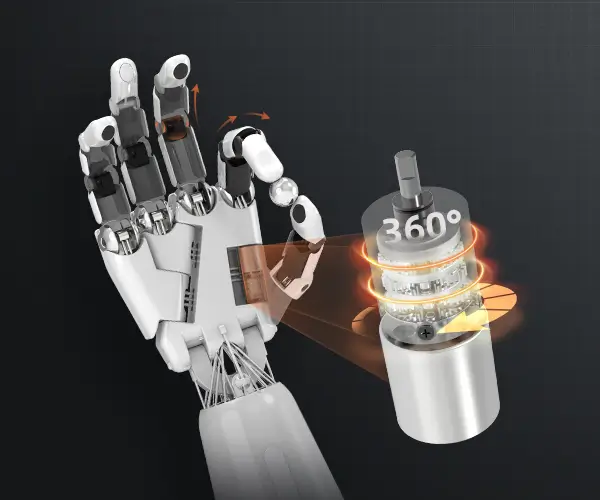part 1:
Unlocking the Potential of Servo Motors with Arduino
Have you ever wondered how robots turn their heads, control robotic arms, or create precise movements? The secret often lies in servo motors—compact, precise, and incredibly versatile components that have revolutionized DIY electronics and robotics. Coupled with the Arduino microcontroller, servo motors open up a universe of possibilities, enabling hobbyists and students to bring their creative ideas to life.

What Is a Servo Motor?
A servo motor is a type of rotary actuator that creates precise angular movements within a specified range, typically from 0 to 180 degrees, though variants exist. Unlike regular motors, which rotate continuously, servos are equipped with internal feedback systems—like potentiometers—that allow them to know their exact position. This feature makes servo motors essential when precise control over movement is required, such as in robotic arms, camera gimbals, or even automated blinds.
The typical components of a servo motor include a small DC motor, a gear train to increase torque, a potentiometer for position feedback, and a control circuit. This assembly can interpret signals—usually PWM (Pulse Width Modulation)—from a microcontroller and translate those into accurate positioning.
Why Use Arduino with Servo Motors?
Arduino, an open-source microcontroller platform, has gained massive popularity owing to its ease of use, affordability, and extensive community support. When paired with servo motors, Arduino becomes a powerful tool for creating projects that require precise movement without the need for complex programming or expensive hardware.
The straightforward nature of Arduino’s programming environment, combined with libraries such as Servo.h, makes it simple even for beginners to get started. Whether it’s a robotic arm that sorts objects, an automated door, or a camera slider, Arduino offers a friendly platform to develop and test these ideas.
Starting Your First Servo Motor Arduino Project
Getting started is easier than you might think. Here’s a quick overview of what you’ll need:
Arduino Board: Such as Arduino Uno, Nano, or Mega. Servo Motor: Standard servo like the SG90 or MG996R. Connecting Wires: To connect the servo to the Arduino. Breadboard: Optional, but helpful for prototyping. Power Source: Usually the Arduino’s 5V output; note that larger servos may require an external power supply.
Once the components are ready, connect the servo’s power line (red) to Arduino 5V, ground (black or brown) to GND, and signal (white or yellow) to a PWM-capable pin like D9.
Here’s a simple example code snippet to make the servo sweep back and forth:
#include Servo myServo; void setup() { myServo.attach(9); } void loop() { for (int pos = 0; pos <= 180; pos += 1) { myServo.write(pos); delay(15); } for (int pos = 180; pos >= 0; pos -= 1) { myServo.write(pos); delay(15); } }
This code demonstrates basic control—pinning the servo to move incrementally across its range, creating simple sweeping motion. But the real magic begins when you start customizing and integrating these movements into larger projects.
Practical and Creative Applications
The real appeal of servo motors lies in their adaptability to a variety of projects:
Robotic Arms: Mimic human arm movements, perfect for grasping or assembly tasks. Camera Gimbals and Pan-Tilt Mechanisms: Stabilize cameras or automate panoramic shots. Automated Plants and Garden Systems: Control watering valves or shading devices with precision. Interactive Art Installations: Use servo motors to animate sculptures or interactive exhibits. Educational Kits: Build models that demonstrate principles of mechanics and robotics.
The scope is huge, limited only by your imagination and the complexity you're willing to tackle. As you grow more comfortable, you can begin to incorporate sensors, switches, and even wireless modules to make your projects more autonomous and intelligent.
Challenges and Considerations
While working on servo motor projects is highly rewarding, keep in mind some quick tips to avoid common pitfalls:
Power Supply: Large or multiple servos can draw significant current. Using the Arduino’s 5V pin for several servos may cause resets or erratic behavior. Consider an external power source with common ground. Servo Size: Standard servos like the SG90 are affordable and suitable for small projects. For heavier applications, look into metal-gear servos which provide higher torque and durability. Precision and Calibration: Some servos may not reach exact specified angles due to manufacturing tolerances. Fine-tuning your code and physical setup can help achieve better accuracy. Library and Code Optimization: Start simple. Use libraries like Servo.h to manage multiple servos easily, and gradually add complexity as you learn.
Next Steps
Having explored the fundamentals, you're now ready to unlock your potential with more advanced projects—adding sensors, creating multi-axis mechanisms, or integrating with IoT systems. The next part of this guide will delve into detailed project ideas, customization tips, troubleshooting strategies, and inspiring examples of Arduino-scorpion projects that demonstrate the versatility of servo motors.
Stay tuned—your journey into autonomous robotics and automation with Arduino and servo motors has just begun. The combination of simple hardware and creative ideas can lead to remarkably sophisticated and fun projects. Whether you're building a dancing robot, a mini CNC machine, or a home automation setup, servo motors are your reliable partners in making movement happen!
Established in 2005, Kpower has been dedicated to a professional compact motion unit manufacturer, headquartered in Dongguan, Guangdong Province, China.




































